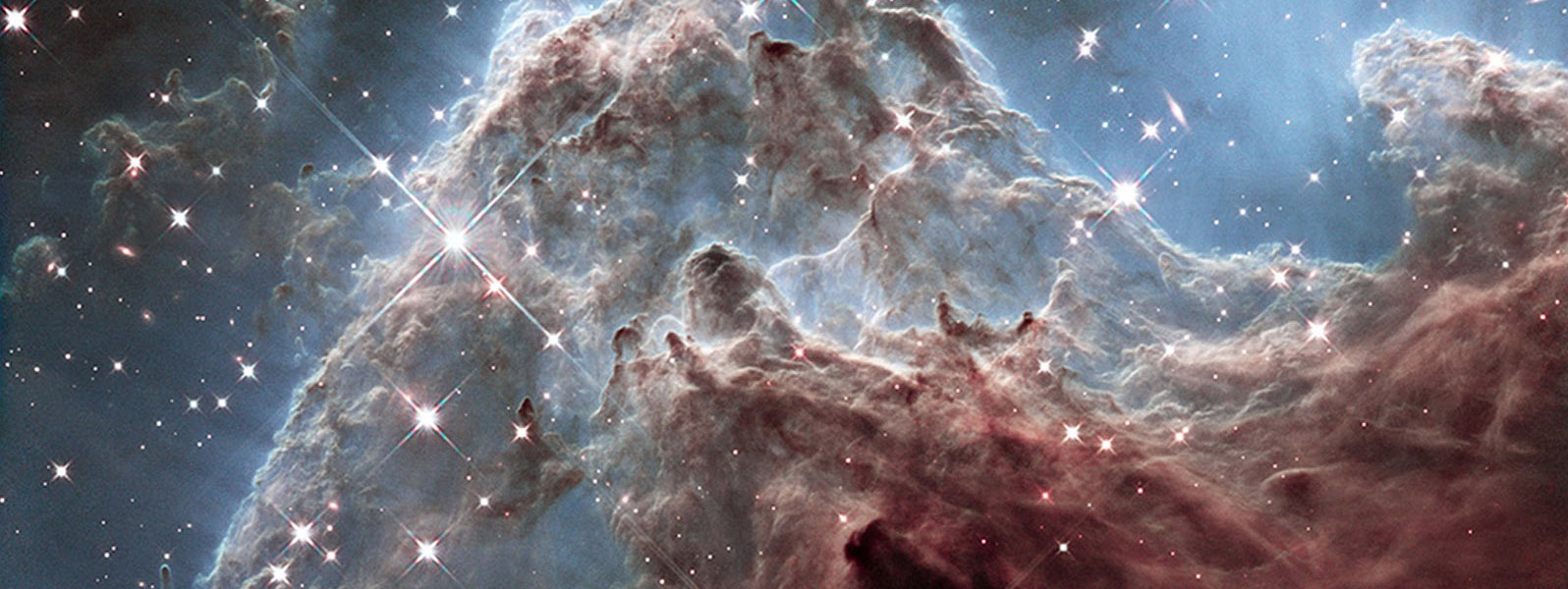Select Gallery View : Slideshow | Thumbnails | PDF

For more information about these technologies visit our Technology Database.

Thin single-crystal silicon X-ray mirror segment (after trimming)

Significance: World-class thin grazing-angle X-ray mirror technology; baselined for Lynx X-ray flagship mission concept
Project Title: Next Generation X-ray Optics: High Resolution, Light Weight, and Low Cost
PI: Zhang, William (GSFC)

X-ray Critical-Angle Transmission (CAT) grating with quarter dollar coin for scale

Significance: Highest-resolution X-ray grating technology; baselined for Lynx X-ray flagship mission concept
Project Title: Development of a CAT Grating Spectrometer
PI: Mark Schattenburg (MIT Kavli Institute for Astrophysics and Space Research)

Modular BICEP3 Focal Plane for Cosmic Microwave Background (CMB) polarimetr

Significance: Developing antenna designs providing sensitivity, stability, and minimized particle susceptibility for bands required by the Inflation Probe, enabling identification of Inflation instants after the Big Bang
Project Title: Planar Antenna-Coupled Superconducting Detectors for CMB Polarimetry
PI: James Bock (JPL/Caltech)

Demonstration model array of Transition-Edge Sensors (TESs)

Significance: TES microcalorimeters offer energy resolution that may enable future missions such as the Lynx X-ray flagship mission concept
Project Title: Advanced X-ray Microcalorimeters: TES Microcalorimeters
PI: Caroline Kilbourne (GSFC)

Single-shell mounting concept with mounted adjustable X-ray mirror and electrical connections

Significance: Adjustable X-ray optics are a backup technology for the Lynx X-ray large mission concept
Project Title: Adjustable X-Ray Optic
PI: Paul Reid (SAO)

REXIS Detector Assembly Module (DAM) with directly deposited filter on the X-ray CCDs

Significance: X-ray detectors operate far better when filters allow X-ray photons through and block longer wavelength light
Project Title: Directly-Deposited Blocking Filters for X-ray Imaging Detectors
PI: Mark Bautz (MIT Kavli Institute for Astrophysics and Space Research)

Digital Micro-mirror Device (DMD) undergoing vibration testing as part of flight qualification

Significance: Replacing windows of commercially available DMDs may enable far-UV multi-object spectrometry in future missi
Project Title: Development of DMDs for Far-UV Applications
PI: Zoran Ninkov (RIT)

Selected parts for 4-to-0.05-K for Continuous Adiabatic Demagnetization Refrigerator (CADR) cooling system fabricated at GSFC

Significance: This advanced sub-Kelvin cooling technology has been baselined by Lynx, Origins, PICO, and GEP
Project Title: High-Efficiency Continuous Cooling for Cryogenic Instruments and sub-Kelvin Detectors
PI: James Tuttle (GSFC)

1.5-m Harris mirror with support structure

Significance: This technology may enable required ultra-stability (~10 pm) for HabEx and LUVOIR missions
Project Title: Predictive Thermal Control (PTC) Technology to enable Thermally Stable Telescopes
PI: H. Philip Stahl (MSFC)

First resonance measurements of mock Cosmic Microwave Background (CMB) detector array

Significance: This and related technologies may enable future CMB missions, e.g. LiteBIRD
Project Title: Technology Development for LiteBIRD and other CMB Missions
PI: Adrian T. Lee (UC Berkeley)

Atomic Layer Deposition (ALD) Multi-Channel Plate (MCP) image detail

Significance: This detector technology is baselined by HabEx, LUVOIR, and CETUS for UV/Visible light detection
Project Title: High-Performance Sealed-Tube Cross-Strip (XS) Photon-Counting Sensors for UV-Vis Astrophysics Instruments
PI: Oswald Siegmund (UC Berkeley)

Molecular Beam Epitaxy (MBE) system at JPL used for coating advanced detectors

Significance: Advanced detectors developed by this project are baselined by SHIELDS, HabEx, LUVOIR, and ground facilities are fabricated using Atomic Layer Deposition (ALD) coatings
Project Title: Advanced FUV/UV/Visible Photon-Counting and Ultralow-Noise Detectors
PI: Shouleh Nikzad (JPL/Caltech)

100×100 mm2 Multi-Channel Plate (MCP) detector mounted on vacuum test system

Significance: Large-format low-noise detectors may enable future far-UV missions
Project Title: Development of 100×100 mm2 photon-counting UV detectors
PI: John Vallerga (UC Berkeley)

Stratospheric Terahertz Observatory (STO2) Balloon-borne observatory being prepared for launch in Antarctica

Significance: This technology provides 4.7-THz Local Oscillators (LOs), enabling far-IR/sub-mm missions such as the balloon-borne Galactic/Extragalactic ULDB Spectroscopic Terahertz Observatory (GUSTO)
Project Title: Raising the Technology Readiness of 4.7-THz local oscillators
PI: Qing Hu (MIT)

40-GHz and 90-GHz feedhorn-coupled focal plane arrays for performing Cosmic Microwave Background measurements

Significance: : CMB measurements may enable identification of the “Inflation” cosmologists believe may have occurred instants after the Big Bang; multi-wavelength measurements can help remove foreground noise
Project Title: High Efficiency Feedhorn-Coupled TES-based Detectors for CMB Polarization
PI: Edward Wollack (GSFC)

Busek components developed for colloid microthrusters for precision spacecraft control

Significance: Microthrusters are critical for controlling the spacecraft of future missions such as the Laser Interferometer Space Antenna (LISA) gravitational-wave observatory
Project Title: LISA Colloid Microthruster Technology
PI: John Ziemer (JPL)

Prototype Laser Interferometer Space Antenna (LISA) telescope designed for room-temp testing

Significance: The LISA gravitational-wave observatory crucially depends on collecting laser light from a remote spacecraft, millions of km away
Project Title: Telescope Development for the LISA Mission
PI: Jeffrey Livas (GSFC)

Prototype laser power amplifier for lasers enabling the Laser Interferometer Space Antenna (LISA) gravitational-wave observatory

Significance: LISA crucially depends on lasers to allow interferometric measurement of the multi-million-km distance between the three spacecraft
Project Title: Laser Technology Development Project for the LISA Mission
PI: Anthony Yu (GSFC)

Torsion pendulum test-bed for gravitational reference sensors used for testing charge management system for the Laser Interferometer Space Antenna gravitational-wave observatory

Significance: LISA crucially depends on charge management to prevent electrostatic noise interfering with interferometric measurement of the multi-million-km distance between the three spacecraft
Project Title: UV LED-based Charge Management System for LISA
PI: John Conklin (University of Florida)

Interferometer testbed built to demonstrate phasemeter and measurement system performance developed for the Laser Interferometer Space Antenna (LISA) gravitational-wave observatory

Significance: LISA needs a phasemeter system to allow interferometric measurement of the multi-million-km distance between the three spacecraft
Project Title: LISA Phasemeter Project
PI: William Klipstein (JPL)

Lab test setup for picometer measurement of mirror dynamics

Significance:Ultra-stability and -precision (~10 pm) may enable the HabEx and LUVOIR missions
Project Title: Ultra-Stable Structure
PI: Babak Saif (GSFC)